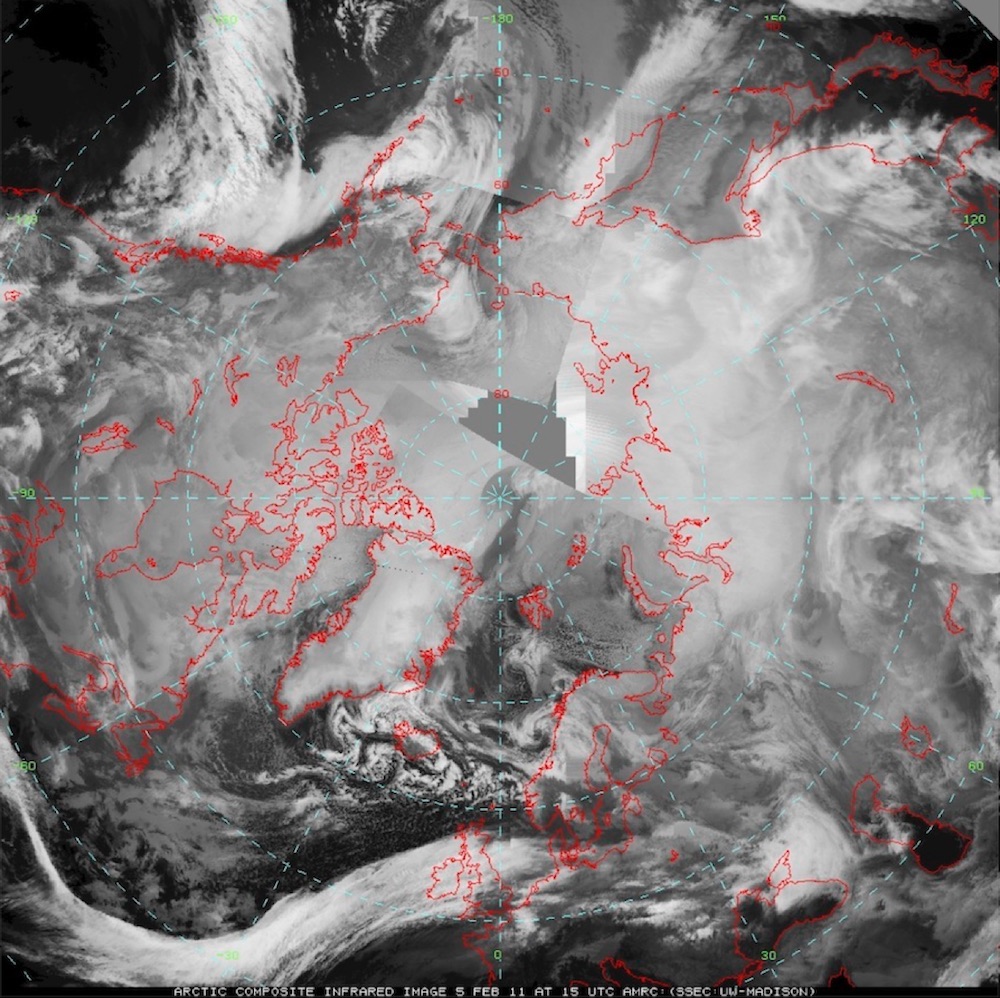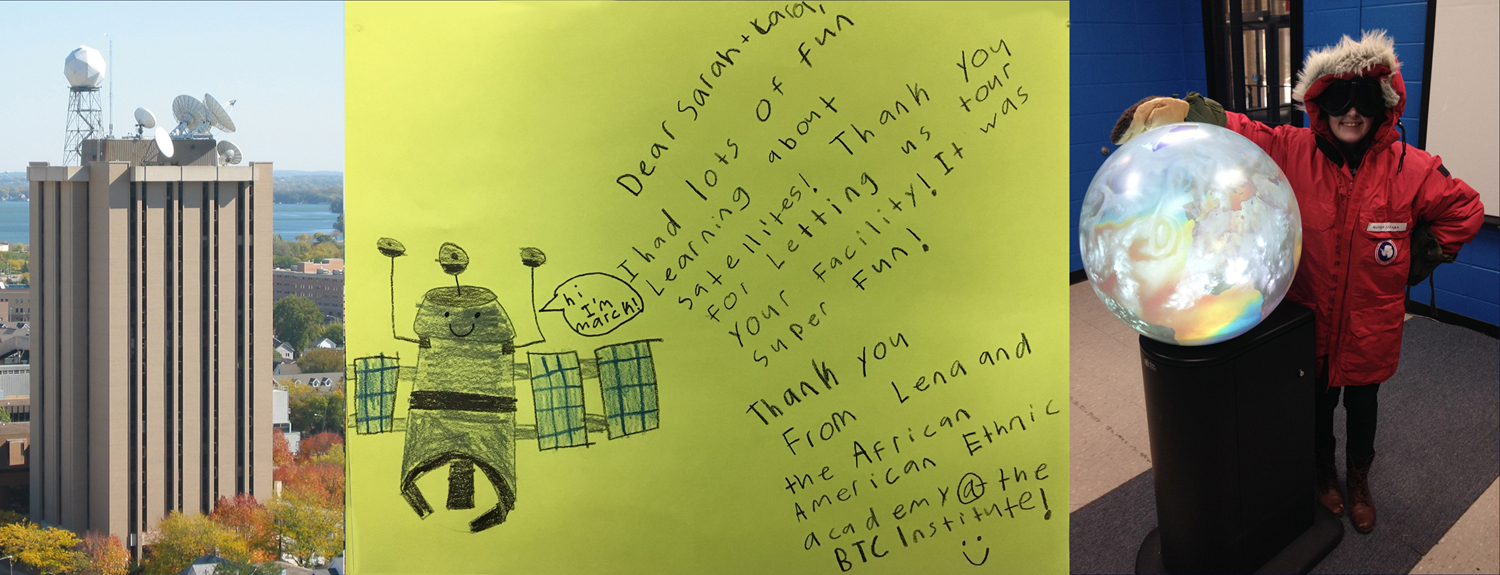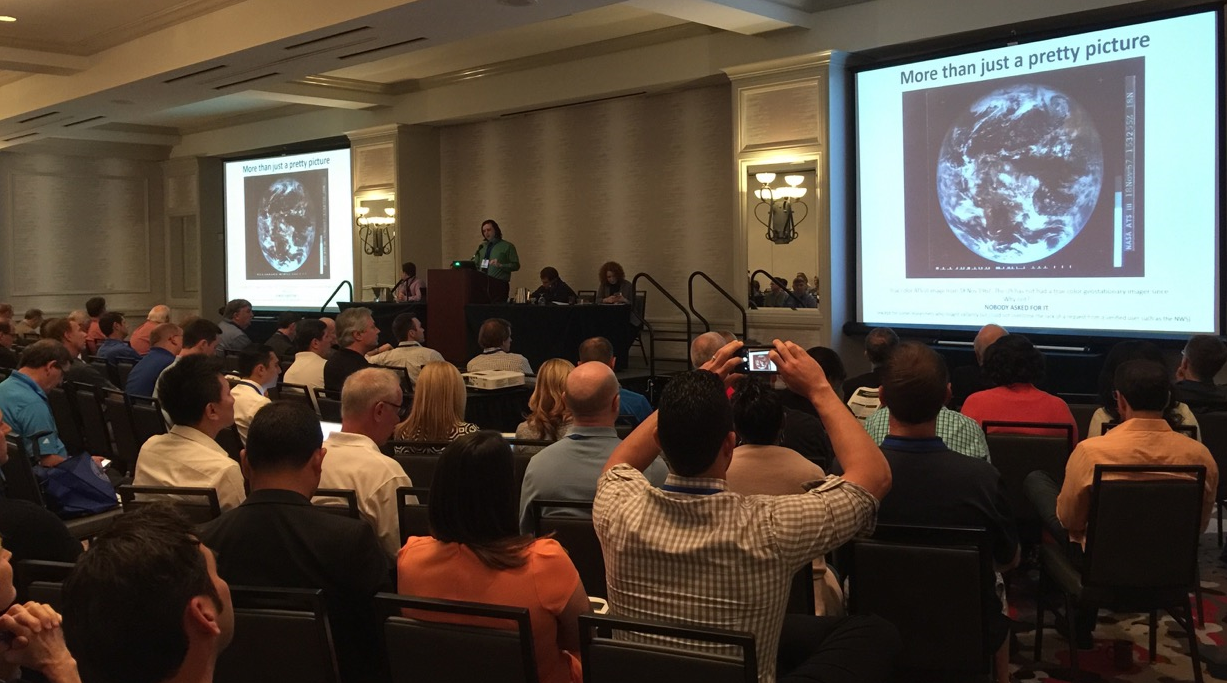
[ Archive ]

 |
CIMSS-NOAA Weekly Report
[ Archive ] |
 |
IN THE PRESS:
ITEMS FOR THE ADMINISTRATOR:
ITEMS FOR THE ASSISTANT ADMINISTRATOR:
ITEMS FOR THE OFFICE DIRECTOR, STAR:
Arctic Composite Satellite Imagery Product Now Operational: The Arctic Composite Satellite Imagery product developed at the University of Wisconsin-Madison Space Science and Engineering Center (SSEC) and Cooperative Institute for Meteorological Satellite Studies (CIMSS) transitioned to operations on June 9, 2016. The product provides an hourly mosaic of geostationary and polar-orbiting satellite data over the Arctic region, which can be used to examine the evolution of weather phenomena through time series of images animations. The satellite data used in the Arctic products include visible, infrared and water vapor imagery from GOES-13, GOES-15, Meteosat-7, Meteosat -10, Himawari-8, NOAA-18, NOAA-19, Metop-A, Metop-B, Aqua and Terra. The products can be viewed in the web-based monitoring tool (http://www.ospo.noaa.gov/Products/imagery/composite.html or http://www.ospo.noaa.gov/Products/imagery/arctic/). The products will be used to improve operational forecasting for the North Pacific and North Atlantic for maritime and aviation operations (Weather and Water, Local Forecast and Warning, Commerce and Transportation). NOAA operational users include Ocean Prediction Center, Weather Prediction Center, NWS Alaska, Geographic Information Network of Alaska (supporting NWS Alaska), National Ice Center, and NOAA Aircraft Operations Center. (M. Lazzara, SSEC; D. Mikolajczyk, SSEC; J. Key, E/RA2, 608-263-2605, jkey@ssec.wisc.edu)
 (Click image to enlarge)
(Click image to enlarge)
Figure caption: An example of the Arctic composite imagery product.
GOES-R Preview for Broadcasters: The short course: “GOES (Geostationary Operational Environmental Satellite)-R Preview for Broadcasters” was successfully held on June 14, 2016 preceding the AMS (American Meteorological Society) Broadcasters’ Conference in Austin, Texas. There was a diverse geographic mix of 20 broadcasters from coast to coast. The goal of the course was to make broadcasters aware of GOES-R capabilities, how they can improve services to the viewing public, where to find additional information on GOES-R, and what equipment upgrades are needed to handle the new data and products. There was a mix of presentations and hands-on exercises on the ABI (Advanced Baseline Imager), the lightning mapper, and derived products. The feedback from the participants included “Very informative, Great overview, Great job by the entire staff, Great Course!” and a request for “Additional GOES-R sessions post launch.” More information, including the presentations, is available at http://cimss.ssec.wisc.edu/goes/shortcourse/austin2016.html. (T. Schmit, E/RA2, 608-263-0291, tim.j.schmit@noaa.gov; M. Gunshor, CIMSS, 608-263-1146; J. Gerth, C. Schmidt, S. Lindstrom)
(Click image to enlarge)
Figure caption: Twitter example from a broadcaster at the GOES-R short course; many broadcasters shared pictures of what was being presented at the twitter handle of #AMS16BC (https://twitter.com/hashtag/AMS16BC?src=hash).
SSEC Hosts Over 1,600 K-12 Visitors in the First Half of 2016: In 2016, the Space Science and Engineering Center (SSEC) at the University of Wisconsin-Madison (UW-Madison) has hosted more than 1,600 elementary, middle, and high school students, and their teachers and chaperones, for demonstrations on our Magic Planet globe, similar to Science On a Sphere (SOS), which was funded in part by a NOAA Education grant to support the SOS Network. Researchers and outreach specialists from SSEC and the Cooperative Institute for Meteorological Satellite Studies (CIMSS) introduce students to satellite meteorology concepts such as historical facts, satellite orbits, satellite capabilities, and current research topics, including the importance of satellites to weather forecasting and the National Weather Service (NWS). Staff from SSEC's Antarctic Meteorological Research Center (AMRC) talk about Antarctic research, demonstrate their cold-weather gear, and give students an up-close look at an anemometer and other weather station instruments. Most visitors, weather permitting, conclude the tour with an escorted trip to the building rooftop for a firsthand look at our satellite dish array. (M. Mooney, CIMSS/SSEC, 608-265-2123, S. Witman, SSEC, C. Costanza (SSEC), M. Gunshor (CIMSS), R. Kohrs (SSEC), Dave Mikolajczyk (SSEC), and D. Stettner (CIMSS).
 (Click image to enlarge)
(Click image to enlarge)
Figure caption: UW-Madison's SSEC engages in extensive in-house outreach activities with thousands of school children every year, with over 1,600 to date in 2016, including exposing students to Antarctic research, Science On a Sphere, and how satellite data are used in research and operations.
Manuscript on Mesoscale Cloud System (MCS) Tracking Using Geostationary Satellite Data Published: An article titled "Life Cycle Characteristics of MCSs in Middle East China Tracked by Geostationary Satellite and Precipitation Estimates" has been published in Monthly Weather Review (vol. 144, no. 7). Co-authors are Yufei Ai, Wanbiao Li, Zhiyong Meng (Peking University) and Jun Li (CIMSS). (Jun Li, 608-262-3755, Jun.Li@ssec.wisc.edu)
ITEMS FOR THE DIVISION CHIEF, CoRP:
Fourth National Climate Assessment Draft Completed: The zero-order draft of the U.S. Global Change Research Program (USGCRP) Climate Science Special Report (CCSR) for the Fourth National Climate Assessment (NCA4) was completed on 10 June 2016. Jim Kossin (NCEI/CWC) is a Lead Author on the report and the Chapter-Lead for Chapter 9, "Extreme Storms". (J. Kossin, NCEI/CWC, 608-265-5356) (Click image to enlarge)
(Click image to enlarge)VISITORS:
JTWC Typhoon Duty Officier Visits CIMSS TC Group: Capt. Brian DeCicco, a Typhoon Duty Officer at the Joint Typhoon Warning Center (JTWC) in Honolulu, HI visited the Cooperative Institute for Meteorological Satellite Studies (CIMSS) from June 13-14. JTWC is responsible for providing tropical cyclone (TC) warnings for Department of Defense (DoD) assets throughout the Pacific and Indian Oceans, covering about 85% of all tropical cyclone activity globally. CIMSS scientists, along with other NOAA scientists collaborating with the CIMSS group, presented Brian with their latest research and current operational products that directly benefit the JTWC TC mission. Brian briefed CIMSS regarding the operational use of the CIMSS and NOAA products utilized at JTWC and provided feedback regarding possible improvements and additions to the current product suite. (C. Velden, CIMSS, 608-262-9168; D. Herndon, CIMSS, 608-262-6741; T. Olander, CIMSS, 608-265-8005; T. Wimmers, CIMSS; S. Griffin, CIMSS, 608-262-0968; C. Rozoff, CIMSS, 608-263-6733; J. Kossin, NOAA/NCEI, 608-265-5356; J. Dunion, NOAA/AOML)
NEXT WEEK:
LOOKING AHEAD:
| Archived Weeklies Page | Submit a report item |